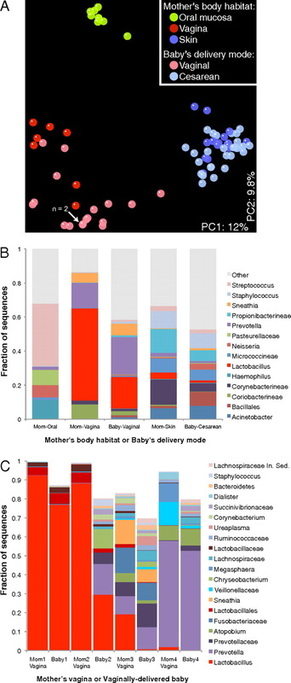 *Image taken from Cho and Blaser (2012) Nature Reviews Genetics
*Image taken from Cho and Blaser (2012) Nature Reviews Genetics Delivery mode impacts newborn's microbiota
With the advancement of Next Generation Sequencing (NGS) techniques, many microbiologists are now able to study in depth the microbial communities within environments of great interest to human health. This is the case for microbiologist Dr. María G. Domínguez–Bello of the University of Puerto Rico-Río Piedras. In 2010, she and her colleagues published an article in which they characterized the bacterial communities of different parts of the body of human babies immediately after they were born (< 5 min), thus contributing in the understanding of the initiation stage of human microbiome development (see figure above for more information about this topic). The interesting part of her work was that she compared the bacterial communities of babies that were born through vaginal delivery vs. those born through cesarean section. Her discovery was remarkable. Not only she demonstrated that newborn babies have undifferentiated bacterial communities across different body habitats but that the composition of such communities is directly correlated to the delivery mode of birth of the infant. Babies that were born through vaginal delivery had a bacterial signature similar to that of their mother's vagina, in which Lactobacillus and Prevotella species dominate. In contrast, babies born through cesarean section showed a bacterial signature similar to their mother's skin (specifically the ventral side of the mother's forearms), in which Staphylococcus species dominate (see figure below for more details).
With the advancement of Next Generation Sequencing (NGS) techniques, many microbiologists are now able to study in depth the microbial communities within environments of great interest to human health. This is the case for microbiologist Dr. María G. Domínguez–Bello of the University of Puerto Rico-Río Piedras. In 2010, she and her colleagues published an article in which they characterized the bacterial communities of different parts of the body of human babies immediately after they were born (< 5 min), thus contributing in the understanding of the initiation stage of human microbiome development (see figure above for more information about this topic). The interesting part of her work was that she compared the bacterial communities of babies that were born through vaginal delivery vs. those born through cesarean section. Her discovery was remarkable. Not only she demonstrated that newborn babies have undifferentiated bacterial communities across different body habitats but that the composition of such communities is directly correlated to the delivery mode of birth of the infant. Babies that were born through vaginal delivery had a bacterial signature similar to that of their mother's vagina, in which Lactobacillus and Prevotella species dominate. In contrast, babies born through cesarean section showed a bacterial signature similar to their mother's skin (specifically the ventral side of the mother's forearms), in which Staphylococcus species dominate (see figure below for more details).
 *Figure taken from Domínguez-Bello et al. (2010) PNAS.
*Figure taken from Domínguez-Bello et al. (2010) PNAS. The trajectory of neonatal gut microbiota of human babies from the moment they are born until they reach 27 months of age.
In addition to the mode of delivery, the microbial communities that colonize the human body throughout the first stages of development (after birth) are greatly influenced by a variety of factors [see the work of Cho and Blaser (2012) for more information]. Interestingly enough, the succession patterns of microbial communities within the gut of human babies show a compositional shift in the abundance of major bacterial taxa over time (Koenig, et al. 2011). This compositional shift can be appreciated in the video below. This video was developed by members of Dr. Rob Knight's lab at the University of Colorado-Boulder. The trajectory that is well illustrated in the video was created from data published by Koenig et al. (2011) and framed against data generated by the Human Microbiome Project (HMP). From the video, you can see that the pattern of succession of the neonatal microbiota shifts from a vaginal-like composition at birth to an adult gut-like composition after 27 months of age.
*References
(1) Cho, I., and Blaser, M.J. (2012) The human microbiome: at the interface of health and disease. Nature Reviews Genetics 13: 260–270.
(2) Domínguez–Bello, M.G. (2010) Delivery mode shapes the acquisition and structure of the initial microbiota across multiple body habitats in newborns. Proc Natl Acad Sci U S A. 107(26): 11971–11975.
(3) Koenig, J.E. et al. (2011) Succession of microbial consortia in the developing infant gut microbiome. Proc Natl Acad Sci U S A. 108(suppl. 1): 4578–4585.
In addition to the mode of delivery, the microbial communities that colonize the human body throughout the first stages of development (after birth) are greatly influenced by a variety of factors [see the work of Cho and Blaser (2012) for more information]. Interestingly enough, the succession patterns of microbial communities within the gut of human babies show a compositional shift in the abundance of major bacterial taxa over time (Koenig, et al. 2011). This compositional shift can be appreciated in the video below. This video was developed by members of Dr. Rob Knight's lab at the University of Colorado-Boulder. The trajectory that is well illustrated in the video was created from data published by Koenig et al. (2011) and framed against data generated by the Human Microbiome Project (HMP). From the video, you can see that the pattern of succession of the neonatal microbiota shifts from a vaginal-like composition at birth to an adult gut-like composition after 27 months of age.
*References
(1) Cho, I., and Blaser, M.J. (2012) The human microbiome: at the interface of health and disease. Nature Reviews Genetics 13: 260–270.
(2) Domínguez–Bello, M.G. (2010) Delivery mode shapes the acquisition and structure of the initial microbiota across multiple body habitats in newborns. Proc Natl Acad Sci U S A. 107(26): 11971–11975.
(3) Koenig, J.E. et al. (2011) Succession of microbial consortia in the developing infant gut microbiome. Proc Natl Acad Sci U S A. 108(suppl. 1): 4578–4585.
 RSS Feed
RSS Feed